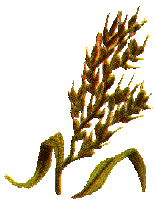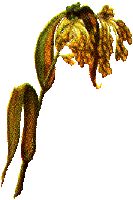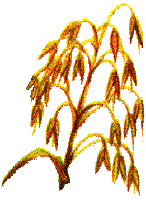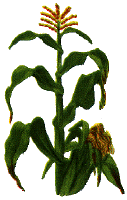In the chart you will find that every planet rules one of the species of grains. To clarify this excerpts from the following book are given:
'HET NIEUWE GRANENBOEK'
(The New Book on Grains)
by
Udo Renzenbrink
To grow grain one must cultivate the land. The Latin word 'culture' means 'bringing culture in the land'. One has to cultivate the land so that culture can develop. In historical documents one finds that the first place where people cultivated the land was in the Persia of old, about 8000 B.C.. (It is said in the Avesta that Deva's - fallen spirits of light - cannot bear grain: 'Where the grains grow richly, the Deva's feel as if red hot iron is burning in their mouths').
A few more indications: Bethlehem means 'city of bread'. The virgin Mary is often painted with a mantle made of ears of grain. In the star constellation 'Virgin' the brightest star is Spica, which means 'ear of cereal'.
A kernel of cereal is made out of: the seed germ, albumen and layers of 'skin'. The outermost layer reminds one of the 'silica mantle' of the human skin. The purest form of silica is crystal.
Silica has the tendency to form 6-sided crystals. The power the I or SELF needs to be able to restrain the body from such a material condensation can be said to make the 'I' alert in using the senses in the physical world.
Silica (bearer of form forces) in the form of silica acid is found in the skin, hair, bones, teeth, connective tissue, ligaments. In a germinal form it is also found in blood.
WHEAT - Sun
In the Persia of olden days people preferred wheat. The religion was a Sun-religion. Ahura Mazdao is an entity of the Sun. Also in the Egypt of old Echnaton was an entity of the Sun. In the Gulf of Morbihan near Lacmarriaquer in Brittany an ear of wheat was used as a sun symbol in the days of the Celts.
Wheat is cultivated all over the world. Sowing and reaping follow the path of the Sun through the seasons. Each month of the year there is harvesting of wheat somewhere on Earth:

| January: | Australia, New Zealand, Burma, the Argentines | |
| February: | India, the Argentines, Uruguay | |
| March: | India, Iran | |
| April: | India, Egypt, Mexico, Iran | |
| May: | North Africa, East Asia, Florida, Texas | |
| June: | USA, Europe, China, Japan | |
| July: | South and Central Europe, England, Norway, Canada, Russia, Japan | |
| August: | Central Europe, England, Norway, Canada, Russia, Japan | |
| September: | Scotland, Scandinavia, Finland, North Russia | |
| October: | Scandinavia, Finland, Northern Russia | |
| November: | South Africa, Peru | |
| December: | Abessinia, Somalia |
Wheat and barley are the oldest kinds of cereal. Once there were only three types: one grain, two grain and spelt. The amount of chromosomes in the nucleus of the cells are resp.: 14, 28 and 42.
In Holland wheat blossoms at the end of May and preferably in the morning hours from 5-9 o'clock and in the afternoon around 3 o'clock. Other grains have other times of blooming.
The wheat kernel is short, compact, round and yellowish red. There is a groove on the back. On top there is a fine brushy beard and there is a small shield at the bottom.
The effects of wheat on the human: Wheat unburdens and supports the processes in the sensory- and nervous system and also in the digestive system , so that the task of the rhythmic mid-section is lightened. The heart is ruled by Sun. Gold is an old healing remedy for the heart - wheat supports this.
RICE - Moon
Rice has a close alliance with the Moon forces. It grows in water (the element which is moved by the Moon in the tides). From the days of old farmers work with the Moon modes in sowing and harvesting. The forces of the Moon are bound up with sprouting and fertility - the building-up forces.

The rice plant can spread out in 20-30 off-shoots that end with a loose rich flowering resembling the plume of an oat. The stalk is 1 to 2 metres high. There is one kernel on each wavy stem. The plume is 20-24 cm long and has 70-90 kernels. This means that one rice plant with its off-shoots, grown from one kernel of rice, has a yield of 1000-3000 kernels of rice! Rice plants have a relatively weak root system which means that rice does not assimilate many minerals.
The percentage of albumen is 7 to 8 % which is low. The percentage of fat is 1.5 % and the percentage of starch is 75 to 80 %.
Of all the cereals rice has to be taken care of most. From sowing till harvesting takes from 3-5 months. The young rice plants must have exactly the right amount of water and warmth.
Rice cultivation probably originated in India and SE Asia and went from there to China around 4000 BC. In many of these countries the word for food and rice is the same. Rice grows well in countries with tropical or sub-tropical climates. Strangely enough Japan chose rice for its most important agricultural product. Japan lies in a temperate zone with hot summers and cold winters so it is not an easy place to grow rice. The rainy summer is just long enough for rice to mature.
BARLEY - Mars
Next to wheat barley is the oldest cereal grass. Where it originated is not known. It can grow all over the world and does.
Barley was the cereal of the old Greeks and the only one which was named. Barley strengthens you and in the Rome of olden days barley was given to the gladiators and they were called 'hordearil' or 'barley-men'. Barley makes you alert and stimulates active thinking.
Of all cereals barley is the first to germinate. There is a vegetation period of 110 days (rye 310, oat 130, corn 120). It prefers long light days. Barley demands good soil.
A kernel of barley is oval, sturdy, gold colored and has a hard tip. In the beard of the barley plant there are silica organs.
MILLET - Mercury

The kernel of millet is the smallest but also the hardest of all grains. The ear is a loose plume. Millet has strong roots and does not demand much of the soil or irrigation. It does need plenty of air and warmth. The vegetation time is 100-110 days.
Silica works in all grain but the most in millet. This activates qualities of form. The fat percentage is 5 %.
Millet used to be a symbol for diligence. It was put in a bride's shoes on her wedding day. In Germany it was also strewn over the bride and bridegroom as a sign of fertility.
Millet is designed by silica and warmth so the heat dissolves and it also has the hard solid quality. Silica is good for eyes, skin, nails; the fluor in millet is good for teeth. It also takes care of 'communication' between the organs.
RYE - Jupiter
Rye doesn't really belong to the soil. It grows in bleak places and especially in high places, for instance around the Matterhorn mountain even up to 2100 m. It likes light, air and coolness and it is winter-fast.
Rye grows in Central Europe, the Netherlands, parts of Scandinavia, Poland, Russia and Austria.

The rye plant is strong. It is 1 m. high and has a mighty ear. It is strongly rooted and the roots loosen the soil. Rye always has a beard and thus a silica process. The kernel is long and has a gray-blue to yellowish color. For a short time the plant has a shining red color. This is when it first breaks through the earth and meets the Sun. From sowing till harvesting takes a whole year so rye lives through all the 12 months. Sowing is in September, harvesting in August.
Rye was the staple diet for the Celts and Slavs. The oldest name in Middle High German is 'rocke' or 'rocko'. The Slavs say 'rusi' (Russia, - russi, russj?).
Rye has strong roots so it has a mineral effect. That means form-giving qualities and stability. Barley makes one alert; rye combines this effect with form-giving qualities.
Rye is good for almost everything in the body, especially for head and limbs. It also has a beneficial effect on the liver through its high kalium percentage.
OAT - Venus

Oat grows best in the sea climate of parts of northern Europe close to the gulf stream. The ear is not compact but in the form of a plume. When it is ripe it rustles in the wind. The plant is 60-259 cm. high and its roots can go down to 250 cm. The plant absorbs much water and by that dries out the soil.
The percentage of fat in oats is much higher than of the other grains, namely 7.1 %. One hundred grams of oat is sufficient for one third of our daily need of fat.
Oats are good for the metabolism of cholesterol, protect heart and arteries and work preventively on arteriosclerose. Oats contain an especially high quality albumen and lots of Vit. B1.
Oats stimulate the emotions, are anti-depressive. By eating oats one is up to more physical exertion. Oats give stamina and endurance and give a larger resistance to climatical changes.
Oats were probably cultivated in Europe first. Historical findings only go back to the bronze period.
CORN - Saturn
Corn is the only kind of cereal that was not brought eastwards after the sinking of Atlantis. It went West instead.

The ears are female and must be inseminated from the top of the plant. Corn exists in all sorts of colors but is usually golden yellow. The rooting is also different than with the other grains. The plant first makes main roots with many side roots but those die off and are replaced by root wreaths which appear out of subterranean buds on the stalk. There is an enormous variety in size: ears from 5 to 40 cm long and the plants grow from 1 to 5 meters high.
Most corn grows in N-America. It needs much warmth (no frost). It can grow anywhere where it can root deeply enough and does not reach the ground water level.
Corn has a high percentage of sugar and a high percentage of Vit. A (cartogene). It is not strongly formed by silica. The sugar is good for the metabolism in the muscle system. American Indians combine corn with beans to ensure stamina.
Man can not live on corn alone otherwise one would get pellagra which is caused by not consuming enough Vit. B and albumen.